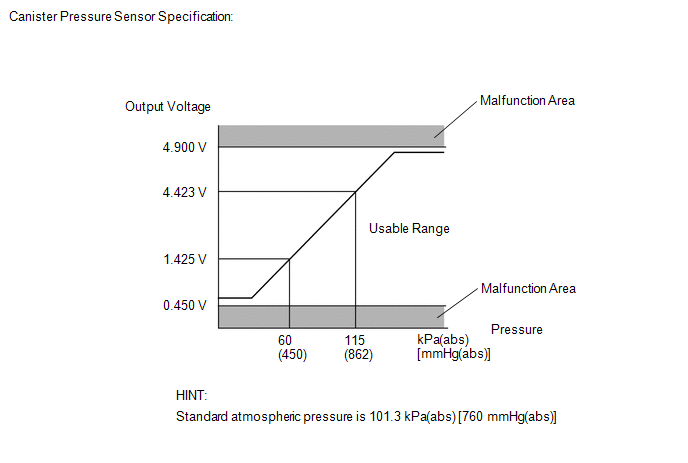- Toyota Tundra Service Manual: Evaporative Emission Control System Pressure Sensor Range / Performance (P0451-P0453)
- Ошибка P0453 — Датчик давления системы улавливания паров топлива — высокий уровень сигнала
- Причины возникновения ошибки P0453
- Каковы симптомы ошибки P0453?
- Как механик диагностирует ошибку P0453?
- Общие ошибки при диагностировании кода P0453
- Насколько серьезной является ошибка P0453?
- Какой ремонт может исправить ошибку P0453?
- Дополнительные комментарии для устранения ошибки P0453
- Нужна помощь с кодом ошибки P0453?
- Toyota Tundra P0453: Fuel Tank Pressure Sensor/Switch Too High
- P0453 Symptoms: Toyota Tundra
- Causes
- Diagnosing P0453 in the Toyota Tundra
- What You can Do at Home
- What a Mechanic Will Do
- Toyota Tundra: P0453 Conclusion
Toyota Tundra Service Manual: Evaporative Emission Control System Pressure Sensor Range / Performance (P0451-P0453)
Sensor output voltage fluctuates frequently within certain time period.
- Canister pump module
- Connector/wire harness (Canister pump module — ECM)
- EVAP system hose (pipe from air inlet port to canister pump module, canister filter, fuel tank vent hose)
- ECM
- EVAP monitoring (ignition switch off)
- Engine running
Canister pressure sensor becomes fixed/flat
Sensor output voltage does not vary in a certain time period.
- Canister pump module
- Connector/wire harness (Canister pump module — ECM)
- EVAP system hose (pipe from air inlet port to canister pump module, canister filter, fuel tank vent hose)
- ECM
- EVAP monitoring (ignition switch off)
Canister pressure sensor low input
EVAP pressure Below 42.1 kPa for 0.5 seconds.
- Canister pump module
- Connector/wire harness (Canister pump module — ECM)
- EVAP system hose (pipe from air inlet port to canister pump module, canister filter, fuel tank vent hose)
- ECM
- Ignition switch ON
- EVAP monitoring (ignition switch off)
Canister pressure sensor high input
EVAP pressure higher than 123.8 kPa for 0.5 seconds.
- Canister pump module
- Connector/wire harness (Canister pump module — ECM)
- EVAP system hose (pipe from air inlet port to canister pump module, canister filter, fuel tank vent hose)
- ECM
- Ignition switch ON
- EVAP monitoring (ignition switch off)
The canister pressure sensor is built into the canister pump module.
The description can be found in the EVAP (Evaporative Emission) system (See page ).
- DTC P0451: Canister pressure sensor noise or fixed/flat If the canister pressure sensor voltage output fluctuates rapidly for 10 seconds, the ECM stops the EVAP system monitor. The ECM interprets this as noise from the canister pressure sensor, and stops the EVAP system monitor. The ECM then illuminates the MIL and stores the DTC (2 trip detection logic). Alternatively, if the sensor voltage output does not change for 10 seconds, the ECM interprets this as the sensor being stuck, and stops the monitor. The ECM then illuminates the MIL and stores the DTC (both malfunctions are detected by 2 trip detection logic).
- DTC P0452: Canister pressure sensor voltage low If the canister pressure sensor voltage output (pressure) is less than 0.45 V: 42.1 kPa-a (315.8 mmHg-a), the ECM interprets this as an open or short circuit malfunction in the canister pressure sensor or its circuit, and stops the EVAP system monitor. The ECM then illuminates the MIL and stores the DTC (1 trip detection logic).
- DTC P0453: Canister pressure sensor voltage high If the canister pressure sensor voltage output (pressure) is higher than 4.9 V: 123.8 kPa-a (928.6 mmHg-a), the ECM interprets this as an open or short circuit malfunction in the canister pressure sensor or its circuit, and stops the EVAP system monitor. The ECM then illuminates the MIL and stores the DTC (1 trip detection logic).
Ошибка P0453 — Датчик давления системы улавливания паров топлива — высокий уровень сигнала
Ошибка P0453 указывает на то, что PCM получил сигнал о слишком высоком давлении от датчика давления системы улавливания паров топлива.
Причины возникновения ошибки P0453
Современные системы улавливания паров топлива включают угольный фильтр, который позволяет улавливать пары топлива и продувать их обратно в двигатель для сгорания. Таким образом, пары топлива не попадают в атмосферу. Также данная система оснащена датчиком давления, который контролирует целостность системы. Через регулярные промежутки времени система улавливания паров топлива выполняет самопроверку, чтобы определить, присутствует ли в системе утечка. Ошибка P4053 появится, если датчик давления системы улавливания паров топлива или датчик давления в топливном баке отправит сигнал о слишком высоком давлении на PCM. Следует отметить, что в некоторых автомобилях датчик давления в топливном баке встроен в электрический топливный насос.
Каковы симптомы ошибки P0453?
При появлении ошибки P0453 на приборной панели автомобиля загорится сигнальная лампа, указывающая на наличие неисправности. Также можно почувствовать запах топлива в салоне автомобиля или снаружи.
Как механик диагностирует ошибку P0453?
Сначала механик подключит сканер OBD-II к диагностическому разъему автомобиля и считает все сохраненные данные и коды ошибок. Особое внимание механик обратит на показания давления в топливном баке.
- Напряжение должно составлять около 2,5 вольт и никогда не превышать 4,5 вольт. Если крышка топливного бака удалена, а напряжение составляет около 2,7 вольт, это может указывать на наличие прерывистой ошибки.
- Механик поверит все провода датчика давления в топливном баке на наличие повреждений. Он измерит напряжение на сигнальном проводе датчика с помощью цифрового вольтомметра. Если во время проведения проверки напряжение будет колебаться, это может указывать на наличие проблемы с электрическими проводами и соединителями (коррозия, обрыв или повреждение).
- Если напряжение составляет больше 4,5 В, механик отсоединит датчик и повторно проверит напряжение. Если напряжение останется высоким, он проверит сигнальный провод на предмет короткого замыкания. Если напряжение упадет, механик проверит заземление и опорное напряжение датчика.
- Если с заземлением и опорным напряжением (должно составлять 5 В) все в порядке, проблема, скорее всего, заключается в самом датчике, и его необходимо заменить.
- Датчик давления также можно проверить с помощью вакуумметра путем подключения к жгуту проводов и наблюдения за изменениями потока данных, используя диагностическое устройство.
- В редких случаях проблема может заключаться в неисправности PCM. Следует отметить, что замена PCM потребует полного перепрограммирования модуля.
Общие ошибки при диагностировании кода P0453
Наиболее распространенной ошибкой при диагностировании кода P0453 является уверенность в том, что причиной возникновения данной ошибки является повреждение или неисправность клапана продувки, клапана вентиляции или крышки топливного бака, в то время как проблема заключается в датчике давления.
Насколько серьезной является ошибка P0453?
При появлении ошибки P0453 вряд ли возникнут серьезные проблемы с управляемостью автомобиля, однако следует отметить, что автомобиль, скорее всего, не сможет пройти проверку на токсичность отработавших газов.
Какой ремонт может исправить ошибку P0453?
- Ремонт или замена проводов
- Ремонт или замена соединителей
- Замена датчика давления системы улавливания паров топлива.
Дополнительные комментарии для устранения ошибки P0453
Поскольку при появлении ошибки P0453 автомобиль, скорее всего, не сможет пройти проверку на токсичность отработавших газов, при обнаружении данного кода рекомендуется как можно скорее обратиться к квалифицированному специалисту для диагностирования и устранения ошибки.
Нужна помощь с кодом ошибки P0453?
Компания — CarChek, предлагает услугу — выездная компьютерная диагностика, специалисты нашей компании приедут к вам домой или в офис, чтобы диагностировать и выявлять проблемы вашего автомобиля. Узнайте стоимость стоимость услуги — автоэлектрик с выездом в Москве или свяжитесь с консультантом по телефону +7(499)394-47-89
Toyota Tundra P0453: Fuel Tank Pressure Sensor/Switch Too High
Your Toyota Tundra utilizes an evaporative emissions control (EVAP) system to migrate fuel vapors from the gas tank and fuel filler neck, and sends them to the engine to be burned off. When the pressure inside of the fuel tank is too high, P0453, is thrown and the check engine light comes on.
If the only trouble code that you have is P0453, your Tundra is in no risk of breaking down. The EVAP system is responsible for migrating fuel vapor. Whether it is doing that or not, has no effect on the way your engine runs. Although, we are not endorsing ignoring this code.
The EVAP system is not always working. It uses a valve to open and close the system to release fuel vapor into the engine to be burned off.
The fuel tank pressure sensor is what detects that the pressure in the system is too high. This is a measure of air pressure in the tank, not fuel pressure. Once it does, P0453 is thrown. The fuel tank pressure sensor is typically on the top of the gas tank, fuel pump, or fuel level sending unit.
The opposite of this code is P0452, which is thrown whenever the system pressure is too low.
P0453 Symptoms: Toyota Tundra
Typically, there are no symptoms associated with this code. The check engine light will illuminate (that’s why you’re here).
The only thing that you may notice is the smell of fuel. If the EVAP system is not properly purging the fuel vapor, it will find other ways to escape.
Causes
Here are the more common causes of P0453:
- Charcoal canister (vent valve or clogged)
- Damaged fuel tank pressure sensor (sensor itself or the wiring)
- Damaged Fuel Tank
- PCM/ECM (highly unlikely)
Diagnosing P0453 in the Toyota Tundra
Diagnosing P0453 in your Tundra can be challenging if you don’t have a scan tool that is capable of reading the fuel pressure sensor data or capable of commanding the vent valve to open and close.
What You can Do at Home
- If you happen to notice the sound of air escaping when you take your Tundra’s gas cap off, that is a telltale sign that the vent valve is bad, or the charcoal canister is bad(it’s pressure leaving the gas tank). After driving for a while, open the gas cap somewhere quiet. It’s hard to notice the sound when you’re at a noisy gas station.
- Check the wiring to the fuel tank pressure sensor and see if it looks frayed or damaged in any way. If it isn’t then the only way to really diagnose it is with a professional mechanic’s scanner. Even this is challenging, since you often need to drop the tank to even look at it.
What a Mechanic Will Do
- A mechanic will capture the fuel pressure sensor data, to see if it is detecting vacuum in the fuel tank.
- They will also command the vent valve to open and close. Depending on the model and year of vehicle in question, you can hear this happening with the engine off.
If the fuel tank pressure data is out of spec, a mechanic will inspect the wiring going to the fuel pressure sensor. If that checks out, the fuel pressure sensor will need replacement.
If the vent valve comes on, and the pressure sensor is fine, then the charcoal canister will need replacement. If the vent valve doesn’t come on, it will need replacement in order to clear P0453.
If everything looks like its is on the up and up, there could be a bent line running from the charcoal canister to the engine, or the PCM is bad.
Toyota Tundra: P0453 Conclusion
That’s pretty much it. While there are only a couple of common things that’ll cause P0453, there it can be tough to diagnose it without the right equipment. It’s not going to leave you stranded on the side of the road either. Good luck fixing your Tundra!
RECALLS! January 2022 Jason, “MAZDA6 shuts down while driving” fuel pump not monitored, may be no engine light etc. SEE…
I have a 2007 h3 hummer base model. Had transmission rebuilt (Pro).My problem is that when it gets around 35…



